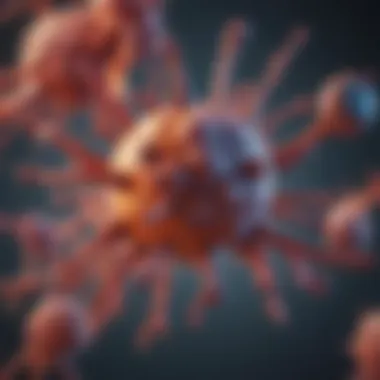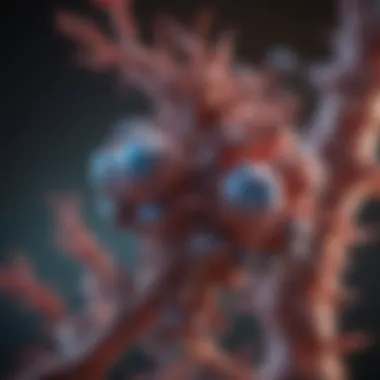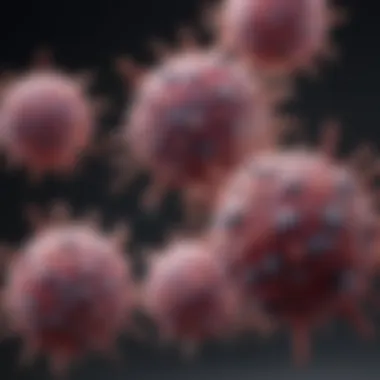Anti-CD3 Antibody: Mechanisms and Applications


Intro
The exploration of anti-CD3 antibodies represents a vital piece in the puzzle of immunology. These antibodies play a significant role in regulating immune responses, particularly within the context of autoimmune diseases and transplant rejection. Understanding their implications and therapeutic potential not only enhances our grasp of the immune system but also informs future strategies for managing various disorders.
The mechanisms through which anti-CD3 antibodies function are intricate, often involving complex interactions with T-cells and the broader immune landscape. With the increasing incidence of autoimmune diseases, such as Type 1 diabetes and multiple sclerosis, as well as the challenges associated with organ transplantation, the relevance of these antibodies becomes ever more pronounced.
By scrutinizing current research trends and scientific principles, this article delves into the depths of anti-CD3 antibodies—shedding light on their biochemical properties and therapeutic applications. It aims to provide a thorough understanding, suitable for students and professionals alike, who are keen to delve into this significant area of study.
Prolusion to Anti-CD3 Antibody
The anti-CD3 antibody has emerged as a crucial player in the landscape of immunotherapy, contributing not just to our understanding of immune modulation but also holding promising potential in therapeutic applications. To grasp the significance of this antibody, it is essential to unravel its basic characteristics, historical underpinnings, and the implications of its unique mechanisms in treating various diseases. The subsequent exploration into this topic aims to provide readers with a solid comprehension of how these antibodies operate and why they are pivotal in contemporary medical research.
Definition and Structure
Anti-CD3 antibodies are engineered proteins designed to target the CD3 complex, a protein found on the surface of T lymphocytes, which are vital for the adaptive immune response. CD3 is part of the T-cell receptor (TCR) complex, and its engagement is necessary for T-cell activation. These antibodies can be categorized based on their source: monoclonal, polyclonal, or humanized, with each type varying in structure and potential efficacy. Their molecular architecture typically comprises an Fc fragment, which mediates effector functions, along with variable regions that confer antigen specificity.
Due to their ability to influence T-cell functionality, anti-CD3 antibodies have been subjects of extensive scientific research. When these antibodies bind to the CD3 complex, they induce changes in T-cell signaling pathways, which can either stimulate or inhibit T-cell activity. This dual capacity makes them not only vital tools in therapeutic approaches but also a topic of significant scientific curiosity.
Historical Background
The journey of anti-CD3 antibodies began in the 1980s, when researchers first identified their potential for modulating immune responses. Initial investigations primarily focused on their role in organ transplantation, where the challenge of preventing rejection was paramount. As we moved into the 1990s, clinical trials demonstrated that anti-CD3 could effectively alter T-cell activation and promote donor organ acceptance.
By the dawn of the 21st century, the scope broadened significantly, expanding into the domain of autoimmune diseases. One of the landmark studies involved the use of the anti-CD3 antibody Teplizumab in treating Type 1 Diabetes. This pivotal moment illustrated not just the therapeutic potential but also unveiled complexities regarding immune tolerance and long-term efficacy in chronic conditions.
The continued evolution of anti-CD3 research is noteworthy. Researchers are actively investigating next-generation anti-CD3 antibodies that promise enhanced efficacy and reduced side effects. Moreover, the intricate interplay of these antibodies with various immune pathways could one day lead to groundbreaking advancements in cancer therapy and personalized medicine. The historical trajectory of anti-CD3 antibodies underscores their importance, setting the stage for an understanding of their current and future applications in medicine.
Mechanisms of Action
Understanding the mechanisms of action of anti-CD3 antibodies is crucial for grasping their therapeutic potential and role in modulating immune responses. These antibodies are engineered to specifically target the CD3 complex, found on the surface of T-cells, which are pivotal in the immune system's functionality. This section elucidates the intricate pathways and processes through which anti-CD3 antibodies exert their effects, ultimately shaping the future of therapies for various conditions, especially autoimmune diseases and organ transplantation.
Binding Specificity
Anti-CD3 antibodies display a remarkable affinity for the CD3 region on T-cell membranes. This specificity enhances the therapeutic efficacy by ensuring that the antibodies predominantly interact with T-cells. When an anti-CD3 antibody binds to CD3, it triggers a cascade of intracellular signals, leading to T-cell activation or modulation.
This binding is not just a matter of chemistry; it's an elegant dance that determines how the immune system will respond under different circumstances. For example, by engaging the CD3 complex, these antibodies can mimic the body’s natural T-cell activation processes, steering them towards a desired immune response. The precision of this interaction also minimizes the unintended consequences that might arise from broader immune system activation, a consideration that is particularly significant in therapies aimed at dampening overactive immune responses seen in autoimmune disorders.
T-cell Activation and Regulation
The role of anti-CD3 antibodies extends deeply into the realms of T-cell activation and regulation. Upon binding to CD3, anti-CD3 antibodies initiate a signaling process that can either activate T-cells or promote their tolerance, depending on the context and dosage. This dual capability makes them valuable in various therapeutic scenarios.
- Positive Activation: In situations where a robust immune response is warranted (such as in cancer therapy), anti-CD3 antibodies can push T-cells into action, enhancing their ability to target and destroy malignant cells.
- Tolerance Induction: Conversely, in the context of autoimmune diseases, the same antibodies can help inculcate a state of immune tolerance, shifting the balance from activation to regulation. This can prevent T-cells from attacking the body’s own tissues and alleviate the symptoms of diseases such as Type 1 diabetes.
The versatility in how these antibodies can influence T-cell behavior makes them an exciting focus of ongoing research, with implications spanning from autoimmune treatment to enhancing transplant acceptance.


Cytokine Release Profiles
A pivotal component of T-cell function is the release of cytokines, signaling molecules that orchestrate immune responses. When anti-CD3 antibodies engage T-cells, they critically influence cytokine profiles, which in turn affect the broader immune landscape.
For instance, some studies have shown that anti-CD3 antibodies can enhance the production of anti-inflammatory cytokines, which may help counteract the harmful effects of pro-inflammatory cytokines often present in autoimmune conditions. This balance between different cytokines is vital in establishing a favorable immune environment.
- Pro-inflammatory Cytokines: These molecules, such as IL-6 and TNF-alpha, can exacerbate autoimmune response where modulation is needed.
- Anti-inflammatory Cytokines: Cytokines like IL-10 can be boosted by anti-CD3 therapy, promoting healing and reducing cellular damage.
"The ability of anti-CD3 antibodies to fine-tune the release of cytokines is a game changer in therapeutic strategies aimed at restoring immune balance."
"The ability of anti-CD3 antibodies to fine-tune the release of cytokines is a game changer in therapeutic strategies aimed at restoring immune balance."
These dynamics underline the potential of anti-CD3 antibodies not just as therapeutic agents but as tools for understanding and harnessing immune system capabilities in a controlled manner.
Therapeutic Applications
The therapeutic applications of anti-CD3 antibodies are pivotal within the realm of immunotherapy. These antibodies serve as crucial agents in various medical contexts, particularly in modulating immune responses to alleviate diseases. Harnessing their mechanisms effectively could lead to breakthroughs in treatment protocols, enhancing patient outcomes across multiple conditions. Anti-CD3 antibodies can help in several ways: by re-establishing immune tolerance, reducing inflammation, and even inducing apoptosis in unwanted immune cells. Such properties make them a significant focus for research and clinical trials.
Autoimmune Diseases
Type Diabetes
Type 1 Diabetes (T1D) stands out as a prime example of how anti-CD3 antibodies are integrated into therapeutic strategies. This autoimmune disease is characterized by the body’s immune system mistakenly attacking insulin-producing beta cells in the pancreas. The uniqueness of T1D lies in its acute onset and often devastating long-term complications, including cardiovascular disease and neuropathy. What makes it a popular focus for anti-CD3 application is the potential to reverse or halt this autoimmune attack.
For instance, research has shown that administering anti-CD3 antibodies can significantly reduce the immune response against these beta cells, thereby preserving some level of insulin production. This characteristic is especially important as it aligns with current trends toward personalized medicine, where interventions are tailored to the individual's unique immune landscape.
However, grappling with the efficacy and duration of response remains a challenge, as not all patients experience the same benefits. Long-term remission is often elusive, and more investigations are necessary to understand the best protocols.
Multiple Sclerosis
Multiple Sclerosis (MS) presents another compelling avenue for anti-CD3 antibody application. This chronic disease affects the central nervous system, leading to varying degrees of disability due to the demyelination of nerve fibers. The key aspect of MS that adds to its complexity is its relapsing-remitting nature, causing unpredictable cycles of symptoms and recovery. Here, the use of anti-CD3 antibodies aims to modulate the immune response, shifting it towards a more balanced state, potentially curbing the inappropriate attacks on the myelin sheath.
The unique feature of employing anti-CD3 in MS treatment is its ability to induce a form of immune tolerance. Unlike some traditional therapies for MS that suppress the entire immune system, anti-CD3 antibodies selectively target the T-cells responsible for the autoimmune response, preserving the overall immune functionality. This nuanced precision can offer a significant advantage, although risks of serious side effects still loom large, compelling researchers to tread carefully.
Transplantation Immunology
In the field of transplantation immunity, anti-CD3 antibodies play a strategic role in preventing organ rejection. Post-transplant, the immune system often sees the new organ as a foreign entity, initiating a cascade of immune responses that can lead to rejection. Here, anti-CD3 acts as a double-edged sword. On one hand, it helps in inducing tolerance toward the transplanted tissue, while on the other, it can heighten the risk of infection due to its immune-modulating effects. The importance of carefully balancing these outcomes cannot be understated, as successful transplantation hinges on the intricate interplay of immune system responses.
Cancer Therapy
In the realm of oncology, the therapeutic use of anti-CD3 antibodies is on the rise. These antibodies can direct the body’s immune system towards targeting and eliminating malignant cells. One of the prominent hopes is to utilize their mechanism to enhance T-cell activation against tumor antigens, essentially re-engaging the body's natural defenses. This application could represent a significant augmentation to existing cancer treatments, potentially offering patients a robust defense against tumor growth.
However, the journey is fraught with challenges. The engagement of the immune system in a concerted attack on cancer cells may lead to collateral damage, impacting healthy cells and leading to adverse reactions.


"The fine line between therapeutic effectiveness and potential immune-related side effects is a crucial consideration in the deployment of anti-CD3 antibodies across various conditions."
"The fine line between therapeutic effectiveness and potential immune-related side effects is a crucial consideration in the deployment of anti-CD3 antibodies across various conditions."
Overall, the therapeutic applications of anti-CD3 antibodies are vast and still under exploration. As research advances, the integration of these antibodies into treatment paradigms promises to reshape how we approach complex diseases like autoimmune disorders, transplant rejection, and cancers.
Clinical Trials and Research Findings
The exploration of anti-CD3 antibodies in clinical settings has underscored their importance not only in scientific inquiry but also in practical therapeutic applications. Clinical trials serve as the ultimate litmus test for evaluating the safety and efficacy of potential treatments. In the context of this article, understanding recent findings and the landscape of ongoing research is vital. It helps delineate how anti-CD3 antibodies influence clinical outcomes and informs further studies that may deepen our understanding of immune modulation.
Recent Key Studies
Recent studies have forged new paths in the understanding of anti-CD3 antibodies, particularly concerning how they interact with various immune mechanisms. For instance, a significant trial published in the Journal of Immunology demonstrated that the administration of anti-CD3 antibodies resulted in marked improvements in the remission rates of patients with Type 1 Diabetes. The results indicated not only the potential to manage this autoimmune disorder but also opened avenues for examining long-term efficacy and potential resistance mechanisms.
Moreover, research led by the National Institutes of Health shed light on the role of anti-CD3 antibodies in Multiple Sclerosis. Their findings revealed a noteworthy reduction in relapse rates among subjects treated with these antibodies. This compelling data indicates that anti-CD3 therapy is making headway in managing previously difficult-to-treat autoimmune conditions.
"The promise that anti-CD3 antibodies hold in translating laboratory results into clinical success cannot be overstated."
"The promise that anti-CD3 antibodies hold in translating laboratory results into clinical success cannot be overstated."
It's also important to highlight the role of collaborative trials that welcome global participation. Such efforts ensure diverse populations are represented in study samples, which potentially leads to more generalizable findings.
Safety Profiles and Efficacy
When it comes to the safety of treatments, few areas are scrutinized as closely as the applications of monoclonal antibodies like anti-CD3. Clinical trials evaluate adverse effects to serve as a warning system against unforeseen complications. For example, in the trials evaluating anti-CD3 for autoimmune diseases, although some mild side effects were observed, such as transient flu-like symptoms, the overall safety profile has remained favorable.
Understanding these safety profiles is crucial for both patients and healthcare practitioners. The known adverse reactions lay the ground for informed decision-making, contributing to a more transparent therapeutic landscape. In a study focusing on kidney transplant recipients, the administration of anti-CD3 antibodies was associated with decreased rates of acute rejection with acceptable safety margins. These findings underscore the balance researchers must maintain between effective treatment and tolerability.
In examining the efficacy of anti-CD3 treatments, trial data have shown that not only do these antibodies engage T-cells effectively, but they also facilitate a marked alteration in cytokine profiles, leading to an adaptive shift in immune responses. This shift could be a game-changer in chronic conditions where immune dysregulation is prevalent, and thus continuing these studies is imperative.
The impact of these clinical trials collectively enhances our understanding of anti-CD3 antibodies, driving forward their therapeutic promise while also highlighting areas that require additional exploration. With a growing body of research to support their application in diverse settings, it is evident that these antibodies may one day hold the key to managing a wide array of immune-related disorders.
Challenges and Limitations
While anti-CD3 antibodies present remarkable opportunities in the realm of immunotherapy, they are not without their challenges and limitations. Understanding these aspects is crucial for harnessing their full potential in clinical applications. The implications of these challenges can significantly impact both research and therapeutic efficacy. Addressing immune tolerance issues and managing potential side effects are essential for optimizing the use of anti-CD3 antibodies in medical settings.
Immune Tolerance Issues
One of the key challenges associated with anti-CD3 antibodies revolves around the concept of immune tolerance. The immune system is designed to differentiate between self and non-self antigens. When anti-CD3 antibodies are introduced, they can paradoxically lead to immune tolerance towards other antigens, especially in patients with autoimmune diseases. This tolerance can prevent the immune system from responding effectively to pathogens or tumor cells, underlining a critical catch-22 in treatment strategies.
For instance, during the course of therapy for conditions such as Type 1 diabetes, excessive modulation of T-cell responses can inhibit the body’s ability to mount a defense against infections. Such outcomes highlight the need for a delicate balance—while the goal is to suppress the autoimmune response, preserving the body’s natural defense mechanisms is also essential. Researchers continue to explore methods to tailor anti-CD3 treatments to circumvent these tolerance issues, ensuring that the benefits outweigh the drawbacks for patients.
Potential Side Effects


The use of anti-CD3 antibodies can also be linked to several potential side effects that warrant attention. One of the most concerning aspects is the risk of cytokine release syndrome (CRS), which can occur shortly after administration. When anti-CD3 antibodies activate T-cells, it can trigger a massive release of cytokines into the bloodstream, leading to symptoms such as fever, hypotension, and organ dysfunction. In severe cases, CRS can prove life-threatening, necessitating careful monitoring and management.
"The balance between treatment efficacy and safety is crucial in the application of anti-CD3 therapies, particularly in vulnerable populations."
"The balance between treatment efficacy and safety is crucial in the application of anti-CD3 therapies, particularly in vulnerable populations."
Moreover, long-term exposure to anti-CD3 antibodies may raise concerns regarding the risk of infections and malignancies due to dampened immune responses. Some studies have reported cases of reactivation of latent viruses, indicating that a thorough understanding of each patient’s background and risk factors is vital before initiating therapy.
Future Perspectives
The future of anti-CD3 antibodies holds significant promise in the landscape of immunological research and therapy. As scientists delve deeper into their mechanisms, a clearer picture emerges of how these antibodies can be tailored and utilized for various diseases. Innovations in this field offer substantial benefits while posing important considerations that must be examined meticulously.
Innovations in Antibody Engineering
One of the most exciting domains in the future of anti-CD3 antibodies lies in the innovations in antibody engineering. Researchers are exploring different ways to enhance the efficacy and specificity of these antibodies, making them even more effective in clinical applications. The development of engineered antibodies that can target CD3 with greater precision could lead to improved outcomes in treatment protocols for autoimmune conditions and transplant rejection.
Techniques such as phage display and computational design are paving the way for the creation of novel antibody formats. Monoclonal antibodies are being modified to include humanized sequences, which could reduce immunogenic responses in patients. Additionally, the use of bispecific antibodies—capable of binding to two different antigens—might allow for simultaneous targeting of CD3 while inhibiting other immune checkpoints, enhancing therapeutic effectiveness.
Some promising innovations include:
- Chimeric Antigen Receptor (CAR) T-cell therapies using anti-CD3 antibodies that can be designed to target tumor cells directly.
- Nanobody technology which allows for smaller, yet highly specific antibodies that penetrate tissues more effectively.
- ADC (Antibody-Drug Conjugates) which combine anti-CD3 with cytotoxic agents to target specific cells more selectively.
These innovations are not just about improving the antibodies themselves but also optimizing the methods for delivery and administration. The possibility of oral formulations or long-acting injectable forms could significantly improve patient adherence and comfort, thereby reshaping treatment paradigms.
Expanding Applications in Diverse Conditions
The potential applications of anti-CD3 antibodies extend beyond just autoimmune diseases and transplantation; the horizon is broadening into various other medical conditions. Researchers are now looking into the implications for conditions such as chronic viral infections, neurological disorders, and even metabolic diseases.
In particular, there’s growing interest in the use of anti-CD3 antibodies for chronic viral infections like the HIV where they could downregulate harmful T-cell responses, thus aiding in better long-term outcomes. In cases of multiple sclerosis, ongoing research suggests that manipulating T-cell responses with these antibodies may enhance remissions and diminish relapses.
Another area ripe for exploration is diabetes management. Anti-CD3 antibodies have shown promise in the preservation of beta-cell function in Type 1 Diabetes patients, thus delaying the need for insulin therapy. As such, studies are expanding to investigate how these antibodies could be integrated into broader treatment strategies in metabolic diseases, where immune components play a pivotal role.
Overall, the future of anti-CD3 antibodies appears both exciting and complex, teeming with possibilities to enhance patient treatments across diverse medical fields. As researchers tackle these avenues, the nuances of immune modulation through engineered antibodies will undoubtedly reshape therapeutic approaches and outcomes, providing fresh hope in areas that have long been challenging.
Closure
In closing this discussion, it’s vital to underscore the significance of anti-CD3 antibodies in immunology and their extensive potential for therapeutics. Their ability to modulate T-cell responses makes them noteworthy players in managing various diseases, particularly autoimmune disorders and in transplantation settings. As researchers peel back the layers of how these antibodies interact with the immune system, new frontiers in treatment emerge, which not only enhances patient care but could reshape the landscape of therapeutic strategies.
Summary of Key Insights
To recapitulate the key points:
- Mechanistic Understanding: The intricacies of how anti-CD3 antibodies bind to their target on T-cells reveal essential insights into immune modulation. Through specific binding, they can facilitate T-cell regulation and induce tolerance, pivotal in preventing organ rejection and managing autoimmune diseases.
- Therapeutic Applications: This article elaborated on the utility of these antibodies in the prevention and treatment of conditions such as type 1 diabetes and multiple sclerosis. It’s clear that the applications are not just limited to one or two areas but span a variety of diseases.
- Research Landscape: The ongoing clinical trials and research advancements highlight a robust landscape that resonates with promise. Nevertheless, challenges like immune tolerance issues and potential adverse effects remain active areas for future investigation.
"The fight against autoimmune conditions represents a complexity almost as intricate as the immune system itself; anti-CD3 antibodies stand at the crossroads, offering hope where there once was none."
"The fight against autoimmune conditions represents a complexity almost as intricate as the immune system itself; anti-CD3 antibodies stand at the crossroads, offering hope where there once was none."
In summary, the therapeutic promise presented by anti-CD3 antibodies is significant. As ongoing research continues to evolve, so too will our understanding and approaches to utilizing these antibodies effectively in clinical settings. By striking a balance between efficacy and safety, the future of anti-CD3 therapy may become even more revolutionary in reshaping how we treat immune-related ailments.







